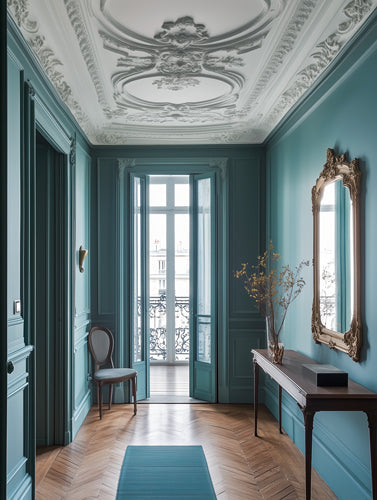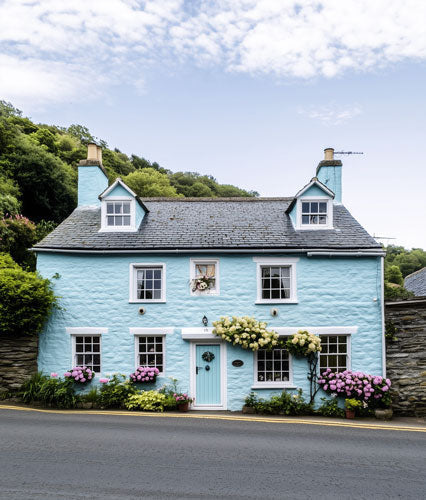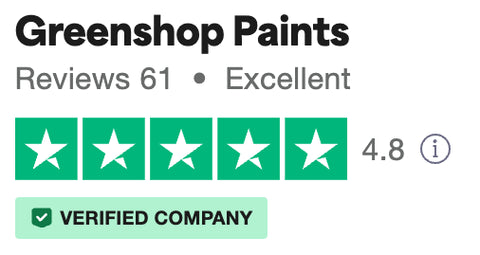Victorian houses were never shy about colour. From soot resistant Brunswick green on front doors to cobalt blues behind stained glass vestibules, every shade had a purpose and a personality.
Today many heritage home owners want to honour that character while keeping surfaces healthy with breathable, zero VOC paint.

Pictured: Graphenstone Red Damask
Exterior Paint Colours for Victorian Homes
Choosing an authentic exterior paint colour for a Victorian house needs a degree of mindfulness of the era’s love of strong contrasts and hardworking finishes.
You don’t always need a completely authentic colour scheme, although you may need to bear any listed building or conservation area constraints in mind. The right colour palette will frame brickwork, show off iron railings and set a confident front door tone, all while allowing the building fabric to breathe.
Use the ideas below as your blueprint for a Victorian exterior paint scheme that accentuates the period features you love on your Victorian home.
Facades, Trim, and Masonry
Victorians loved contrast. London stock brick often sat beneath stone coloured string courses, while stuccoed villas featured pale putty paints that made dark iron railings pop. If your house is brick, keep walls natural and highlight bands or window heads in a cream like Bath Stone. Deal Stairs is another cream shade that may be suitable.
Bath Stone and Deal Stairs are both available in our English Heritage Paint range by Graphenstone.
Victorian Front Door Colours
Era appropriate colours help compliment Victorian Facades. During the Victorian period, more people were socially mobile.
Appearances mattered, and the front doors were kept in pristine condition. Highly polished brass, ornate fanlights, and stained glass would set a grand scene to impress visitors.
Popular Victorian front door colours include:-
Deep Brunswick green to disguise coal dust and complement brass. Indian red for a rich, earthy welcome. Gloss black or very dark navy for a smart townhouse look.
Changing Colours on Listed Buildings & in Conservation Areas
Bear in mind that if your home is a listed building, or you live in a conservation area, you may need planning permission to change the colour of your home exterior or front door. Any work which may change the character of a building in one of these categories should be discussed with your local council planning officer before works commence. That includes paint colour changes.
Quick checklist before you start:- Check if your house is Grade II or simply within a conservation area. Photograph existing finishes before changing them. Email your local council planning officer to discuss the nature of the changes before painting.
Interior Colour Schemes
Victorian interior colour schemes were designed to create a sense of opulence. Victorian hallways and staircases needed to be both dramatic and durable, whilst dining areas were decorated in rich intimate shades.
Victorian Hallways and Staircases
High traffic areas like hallways and stairs in Victorian homes demanded dark, practical colours. Oxblood reds, chocolate browns, and peacock blues work well with encaustic tiles. Use a deep tone below the dado rail and stone drab above.
Inspiration: Smalt Blue in our GrafClean Premium finish - delivers the cobalt punch hallways deserve.
Victorian Drawing and Living Room Colours
Drawing and living rooms were used as a showcase for new synthetic pigments in the Victorian period. Peacock blue, olive green, or Venetian red on walls, with a lighter ceiling to lift evening light.
Inspiration: Pavilion creates a refined teal backdrop.
Victorian Dining Rooms and Fireplaces
Dark ceilings added intimacy. Try bottle green overhead, then frame a slate fireplace in eggshell black.
Inspiration: Blackbean in Eggshell gives lacquer-like depth without harsh fumes.
Popular Victorian Paint Colours
Victorian Greens
Victorian taste embraced every shade between soft celadon “arsenic” greens used in parlours and the dense, soot-masking Brunswick greens that framed front doors and garden railings, creating a spectrum that felt both refined indoors and resilient against the grime of industrial streets.
Inspiration: Butler’s Green supplies mid-tone elegance for early terrace sashes, while Gables Green delivers authentic depth for doors or railings. Brunswick green is perfect for a dramatic hallway.
Pictured: Graphenstone Brunswick Green.
Victorian Blues
Victorian blue paint colours were very much the fashion of the time. Cobalt and indigo tones signalled status, while brighter peacock and Prussian shades showed off the latest synthetic pigments. Deep blues paired beautifully with mahogany furniture, gilt picture rails, and encaustic tile borders, creating rooms that felt both opulent and modern under gaslight.
Inspiration: Entrance Hall Blue brings teal energy to tiled corridors, and Smalt Blue offers dramatic saturation for dining rooms.

Pictured: Graphenstone Entrance Hall Blue
Victorian Reds, Pinks, and Purples
Oxblood and damask reds dominated formal rooms. Red Damask is ideal for sitting rooms. Parlour Pink softens morning rooms, while deep purple appeared mainly in ecclesiastical settings.
Why Colour Matters in Victorian Homes
Victorian paint colours are part of your home’s fabric and story. Pair authentic palettes with breathable natural coatings and you will protect the building’s health while letting its character shine.
Order your free colour chart or buy a reusable colour swatch today, then test each shade in morning and evening light to discover the perfect fit.
Victorian Paint Colour FAQs
What are classic Victorian colours?
Victorians favoured a dark, luxurious palette: maroon, deep red, burgundy, chestnut, dark green, rich red based browns, and dark navy and cobalt blues.
Is pink a Victorian colour?
Yes. Pink was prized in the Victorian era. Soft pink shades were favoured for debutante gowns and richer pink satins and silks for the evening wear of more mature women.
Further reading: Heritage paints for period properties | Paint colours for period properties





